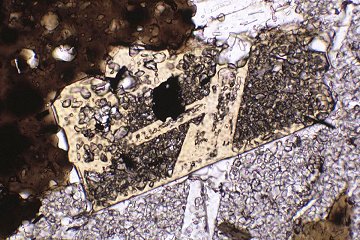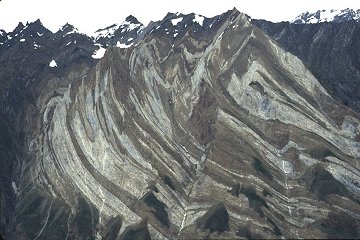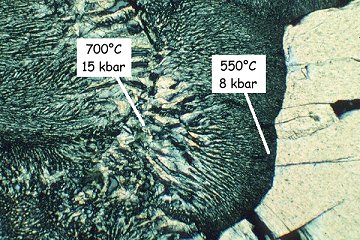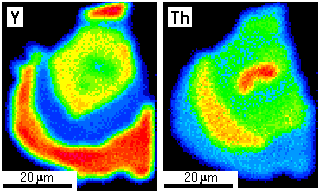Dave Waters - Metamorphic Petrology Research at Oxford
Metamorphic rocks retain a wealth of information about their history in their microstructures and compositional patterns. Making use of this record involves two strands of study:
- Learning about the fundamental processes of metamorphic change, and in particular how the observed patterns reflect the thermodynamics and kinetics of mineral reactions.
- Using this knowledge to determine pressure-temperature-time paths for deep-seated metamorphic rocks, with the aim of solving problems in continental tectonics.
Microscopic observations, therefore, are a key to understanding crustal-scale processes. My research forms an integral part of collaborations with Prof M. P. Searle, Prof L. J. Robb and external co-workers, and involves several graduate students. Our principal tools are the polarising microscope, scanning electron microscope, and the electron probe microanalyser. For more about the activities of the wider research group, visit the Hard Rock Group website.
Fundamental processes: microstructure and kinetics
 Large thermal aureoles, such as that beneath the
mafic rocks of the Bushveld Complex, South Africa,
provide an environment of known thermal history for
testing the predicted relationships between the rates
of heating, nucleation and growth, which are
ultimately expressed in metamorphic reaction
microstructures and crystal size distributions.
A quantitative model has been developed to
account for the decrease in observed porphyroblast
size with increasing grade and constrain the
overstepping required to drive metamorphic reactions.
Subtle detail in the microstructure (see
illustration) indicates sequences of mineral growth
that cannot be matched by equilibrium thermodynamic
models, suggesting that barriers to nucleation are
sufficient to allow metastable reaction sequences to
occur, at least in the static environment of contact
metamorphism. Continuing research is exploring other settings in
which the microstructural and microchemical record of prograde
metamorphism shows significant deviation from the predicted
equilibrium behaviour.
Large thermal aureoles, such as that beneath the
mafic rocks of the Bushveld Complex, South Africa,
provide an environment of known thermal history for
testing the predicted relationships between the rates
of heating, nucleation and growth, which are
ultimately expressed in metamorphic reaction
microstructures and crystal size distributions.
A quantitative model has been developed to
account for the decrease in observed porphyroblast
size with increasing grade and constrain the
overstepping required to drive metamorphic reactions.
Subtle detail in the microstructure (see
illustration) indicates sequences of mineral growth
that cannot be matched by equilibrium thermodynamic
models, suggesting that barriers to nucleation are
sufficient to allow metastable reaction sequences to
occur, at least in the static environment of contact
metamorphism. Continuing research is exploring other settings in
which the microstructural and microchemical record of prograde
metamorphism shows significant deviation from the predicted
equilibrium behaviour.
Applications to continental tectonics
1. The metamorphic core of the Himalaya and Karakoram
 The
metamorphic rocks in the axial zones of mountain
belts preserve a record of the behaviour of
continental crust during collision. In the NW Zanskar
Himalaya, for example, crustal thickening is revealed
both in kilometre-scale structures (pictured here is
the closure of the Donara nappe) and at the
microscopic scale of mineral growth and fabric
development. We extract pressure-temperature paths
from compositionally-zoned garnets that grew during
compressive deformation, using the thermodynamic data
set and calculation program
THERMOCALC.
Here, we find a steady increase in both P
and T, rather than the P increase followed by thermal
relaxation commonly proposed for idealised
collisional orogeny. Similar techniques are being deployed to
unravel the extended and complex internal history of the Karakoram
Metamorphic Complex in the Hunza and Baltoro regions.
We are also working to constrain
the amount, timing and rate of exhumation associated
with major fault systems (such as the South Tibetan
Detachment system) in the Everest area, in Zanskar, and at
Nanga Parbat in the NW Himalaya. To circumvent shaky
assumptions about thermal gradients during cooling
through mineral blocking temperatures, this is being
done by direct pressure determinations on peak and
retrograde mineral associations, and by numerical
modelling of the temperature-depth evolution.
The
metamorphic rocks in the axial zones of mountain
belts preserve a record of the behaviour of
continental crust during collision. In the NW Zanskar
Himalaya, for example, crustal thickening is revealed
both in kilometre-scale structures (pictured here is
the closure of the Donara nappe) and at the
microscopic scale of mineral growth and fabric
development. We extract pressure-temperature paths
from compositionally-zoned garnets that grew during
compressive deformation, using the thermodynamic data
set and calculation program
THERMOCALC.
Here, we find a steady increase in both P
and T, rather than the P increase followed by thermal
relaxation commonly proposed for idealised
collisional orogeny. Similar techniques are being deployed to
unravel the extended and complex internal history of the Karakoram
Metamorphic Complex in the Hunza and Baltoro regions.
We are also working to constrain
the amount, timing and rate of exhumation associated
with major fault systems (such as the South Tibetan
Detachment system) in the Everest area, in Zanskar, and at
Nanga Parbat in the NW Himalaya. To circumvent shaky
assumptions about thermal gradients during cooling
through mineral blocking temperatures, this is being
done by direct pressure determinations on peak and
retrograde mineral associations, and by numerical
modelling of the temperature-depth evolution.
2. The formation and exhumation of eclogites in collision zones
 We are
studying eclogite-facies rocks, formed from
continental material of shallow origin, in Norway,
Oman, parts of the Himalayan chain, and the Western Alps. Eclogites
form at depths in excess of 50 km, deeper than the
base of normal continental crust, and special
mechanisms must operate to drive buoyant crust down
to mantle depths, and to return some of it to the
surface. In western Norway, parts of the Western
Gneiss Region have experienced pressures > 30 kbar
(100 km depth) and contain relics of coesite, the
high-density silica polymorph. We have shown that
these ultra-high pressure rocks form a distinct unit
that can be differentiated from lower-pressure (ca.
20 kbar) eclogites on petrographic and mineral
composition criteria as well as on evidence for the
former presence of coesite.
We are
studying eclogite-facies rocks, formed from
continental material of shallow origin, in Norway,
Oman, parts of the Himalayan chain, and the Western Alps. Eclogites
form at depths in excess of 50 km, deeper than the
base of normal continental crust, and special
mechanisms must operate to drive buoyant crust down
to mantle depths, and to return some of it to the
surface. In western Norway, parts of the Western
Gneiss Region have experienced pressures > 30 kbar
(100 km depth) and contain relics of coesite, the
high-density silica polymorph. We have shown that
these ultra-high pressure rocks form a distinct unit
that can be differentiated from lower-pressure (ca.
20 kbar) eclogites on petrographic and mineral
composition criteria as well as on evidence for the
former presence of coesite.
Mechanisms for the exhumation of Norwegian and Himalayan eclogites can be illuminated by studying the minerals and microstructures formed during decompression. We have studied the compositions of amphiboles and other hydrous minerals that have grown during the exhumation, and record the recycling of aqueous fluids in the subduction zone at 15 - 20 kbar (50 - 70 km depth). The fine-grained mineral intergrowths (symplectites, see photomicrograph) that replace eclogite-facies phases show systematic trends in composition and lamellar spacing, which appear to record a two-stage exhumation history, with initial rapid decompression followed by formation of the intergrowths on a cooling trajectory from about 14 kbar, 700°C. Therefore, the onset of symplectite growth probably marks the transition from buoyancy-driven uplift to a slower, tectonically-driven mechanism at this depth, perhaps controlled by extensional shear zones.
3. The cratonisation process: granulites, migmatites and charnockites in Precambrian terrains
 The consolidation of new or reworked
continental crust involves granulite-facies
metamorphism, partial melting, and the emplacement of
water-undersaturated magmas. Even in rocks subjected
to such high temperatures, a record of the processes
remains, either in outcrop-scale textures of
migmatitic rocks, or in the small-scale compositional
patterns within refractory minerals. The rare-earth
phosphate monazite (illustrated) holds particular
promise, as the growth zones can in principle be
dated as well as correlated with the reaction history
of the rock. For example in Namaqualand (South
Africa), field relationships, reaction
microstructures, calculated mineral equilibria,
in-situ monazite dating (provisional) and
geochemical mass balance tell us that granulites
formed in the middle crust (15 - 20 km depth) at ca.
1060 - 1030 Ma on a path of increasing pressure
during heating to 850°C. They lost a small amount
of melt, sufficient to remove the water from the
breakdown of hydrous minerals, and underwent only
limited back-reaction with residual melt at ca. 1020
- 1010 Ma.
The consolidation of new or reworked
continental crust involves granulite-facies
metamorphism, partial melting, and the emplacement of
water-undersaturated magmas. Even in rocks subjected
to such high temperatures, a record of the processes
remains, either in outcrop-scale textures of
migmatitic rocks, or in the small-scale compositional
patterns within refractory minerals. The rare-earth
phosphate monazite (illustrated) holds particular
promise, as the growth zones can in principle be
dated as well as correlated with the reaction history
of the rock. For example in Namaqualand (South
Africa), field relationships, reaction
microstructures, calculated mineral equilibria,
in-situ monazite dating (provisional) and
geochemical mass balance tell us that granulites
formed in the middle crust (15 - 20 km depth) at ca.
1060 - 1030 Ma on a path of increasing pressure
during heating to 850°C. They lost a small amount
of melt, sufficient to remove the water from the
breakdown of hydrous minerals, and underwent only
limited back-reaction with residual melt at ca. 1020
- 1010 Ma.
Recent Publications
Waters, D.J. (2019). Metamorphic constraints on the tectonic evolution of the High Himalaya in Nepal: the art of the possible. In: Treloar, P.J. & Searle, M.P. (eds), Himalayan Tectonics: A Modern Synthesis, Geological Society, London, Special Publications, 483, https://doi.org/10.1144/SP483-2018-187
Lamont, T.N., Searle, M.P., Waters, D.J., Roberts, N.M.W., Palin, R.M.,
Smye, A.J., Dyck, B.J., Gopon, P., Weller, O.M. and St-Onge, M.R. (2019).
Compressional origin of the Naxos metamorphic core complex, Greece: Part 1. Structure,
petrography, and thermobarometry. Geological Society of America Bulletin,
https://doi.org/10.1130/B31978.1
Forshaw, J.B., Waters, D.J., Pattison, D.R.M., Palin, R.M. and Gopon, P. (2019). A comparison of observed and thermodynamically predicted phase equilibria and mineral compositions in mafic granulites. Journal of Metamorphic Geology, 37, 153–179. https://doi.org/10.1111/jmg.12454
Waters, D.J., Law, R.D., Searle, M.P. and Jessup, M.J. (2019). Structural and thermal evolution of the South Tibetan Detachment shear zone in the Mt. Everest region, from the 1933 sample collection of L.R. Wager. In: Ferrero, S., Lanari, P., Goncalves, P. and Grosch, E. (eds) Metamorphic Geology: Microscale to Mountain Belts, Geological Society, London, Special Publications, 478, 335–372. https://doi.org/10.1144/SP478.17
Ambrose, T.K., Wallis, D, Hansen, L.N., Waters, D.J. and Searle, M.P. (2018). Controls on the rheological properties of peridotite at a palaeosubduction interface: A transect across the base of the Oman–UAE ophiolite. Earth and Planetary Science Letters, 491, 193–206. https://doi.org/10.1016/j.epsl.2018.03.027
Searle, M.P., Morley, C.K., Waters, D.J., Gardiner, N.J, U Kyi Htun and Robb, L.J. (2017). Tectonic and metamorphic evolution of the Mogok Metamorphic and Jade Mines belts and ophiolitic terranes of Burma (Myanmar). In: Barber, A.J., Khin Zaw & Crow, M.J. (eds). Myanmar: Geology, Resources and Tectonics. Geological Society, London, Memoirs, 48, 261–293. https://doi.org/10.1144/M48.12
Weller, O.M., St-Onge, M.R., Rayner, N., Waters, D.J., Searle, M.P. and Palin, R.M. (2016). U-Pb zircon geochronology and phase equilibria modelling of an eclogite from the Sumdo complex of south-east Tibet: insights into metamorphic zircon crystallisation, eclogite exhumation and the assembly of the Tibetan plateau. Lithos, 262, 729-741. https://doi.org/10.1016/j.lithos.2016.06.005
Palin, R.M., Weller, O.M., Waters, D.J. and Dyck, B. (2016). Quantifying geological uncertainty in metamorphic phase equilibria modelling; a Monte Carlo assessment and implications for tectonic interpretations. Geoscience Frontiers, 7, 591–607. https://doi.org/10.1016/j.gsf.2015.08.005
Weller, O.M., St-Onge, M.R., Rayner, N., Searle, M.P. and Waters, D.J. (2016). Miocene magmatism in the Western Nyainqentanglha mountains of southern Tibet: An exhumed bright spot? Lithos, 245, 147-160. https://doi.org/10.1016/j.lithos.2015.06.024
Searle, M.P., Waters, D.J., Garber, J.M., Rioux, M., Cherry, A.G. and Ambrose T.K. (2015). Structure and metamorphism beneath the obducting Oman ophiolite: Evidence from the Bani Hamid granulites, northern Oman mountains. Geosphere, 11 (6), online 2 October 2015. https://doi.org/10.1130/GES01199.1
Palin, R.M., Weller, O.M., Waters, D.J. and Dyck, B. (2015). Quantifying geological uncertainty in metamorphic phase equilibria modelling; a Monte Carlo assessment and implications for tectonic interpretations. Geoscience Frontiers, 7, 591–607. https://doi.org/10.1016/j.gsf.2015.08.005
Weller, O.M., St-Onge, M.R., Rayner, N., Searle, M.P. and Waters, D.J. (2016). Miocene magmatism in the Western Nyainqentanglha mountains of southern Tibet: An exhumed bright spot? Lithos, 245, 147-160. https://doi.org/10.1016/j.lithos.2015.06.024
White, A.J.R., Waters, D.J. and Robb, L.J. (2015). Exhumation-driven devolatilization as a fluid source for orogenic gold mineralization at the Damang deposit, Ghana. Economic Geology, 110 (4), 1009–1025. doi: 10.2113/econgeo.110.4.1009 [7]
Palin, R.M., Searle M.P., St-Onge M.R., Waters D.J., Roberts N.M.W., Horstwood M.S.A., Parrish R.R. and Weller O.M. (2015). Two-stage cooling history of pelitic and semi-pelitic mylonite (sensu lato) from the Dongjiu–Milin shear zone, northwest flank of the eastern Himalayan syntaxis. Gondwana Research, 28 (2), 509–530. DOI: 10.1016/j.gr.2014.07.009 [3]
Weller, O.M., St-Onge M.R., Searle M.P., Waters D.J., Rayner N., Chen S., Chung S-L. and Palin R.M. (2015). Quantifying the P–T–t conditions of north–south Lhasa terrane accretion: new insight into the pre-Himalayan architecture of the Tibetan plateau. Journal of Metamorphic Geology, 33 (1), 91–113. DOI: 10.1111/jmg.12112 [5]
Cowan, R.J., Searle, M.P. and Waters, D.J. (2014). Structure of the Metamorphic Sole to the Oman ophiolite, Sumeini Window and Wadi Tayyin: implications for ophiolite obduction processes. In: Rollinson, H.R., Searle, M.P., Abbasi, I.A., Al-Lazki, A. & Al-Kindi, M.H. (eds), Tectonic Evolution of the Oman Mountains, Geological Society, London, Special Publications, 392, 155–175. DOI: 10.1144/SP392.8
R.M. Palin, M.R. St-Onge, D.J. Waters, M.P. Searle and B. Dyck (2014). Phase equilibria modelling of retrograde amphibole and clinozoisite in mafic eclogite from the Tso Morari massif, northwest India: constraining the P–T–M(H2O) conditions of exhumation. Journal of Metamorphic Geology, 32 (7) 675–693. DOI: 10.1111/jmg.12085
White, A.J.R., Burgess, R., Charnley, N.R., Selby, D., Whitehouse, M.J., Robb, L.J. and Waters D.J. (2014). Constraints on the timing of late-Eburnean metamorphism, gold mineralisation and regional exhumation at Damang mine, Ghana. Precambrian Research, 243, 18–38. DOI: 10.1016/j.precamres.2013.12.024
Palin, R.M, Searle, M.P., St-Onge, M.R., Waters, D.J., Roberts, N.M.W., Horstwood, M.S.A., Parrish, R.R., Weller, O.M., Chen, S., and Yang, J. (2014). Monazite geochronology and petrology of kyanite-and sillimanite-grade migmatites from the northwestern flank of the eastern Himalayan syntaxis. Gondwana Research, 26 (1), 323–347. DOI: 10.1016/j.gr.2013.06.022
White, A.J.R., Waters, D.J. and Robb, L.J. (2013). The application of P–T–X(CO2) modelling in constraining metamorphism and hydrothermal alteration at the Damang gold deposit, Ghana. Journal of Metamorphic Geology, 31 (9), 937–961. DOI: 10.1111/jmg.12051
Weller, O.M., St-Onge M.R., Waters D.J., Rayner N., Searle M.P., Chung S-L., Palin R.M., Lee Y-H., and Xu X. (2013). Quantifying Barrovian metamorphism in the Danba Structural Culmination of eastern Tibet. Journal of Metamorphic Geology, 31 (9), 909–935. DOI: 10.1111/jmg.12050
St-Onge, M.R., Rayner, N., Palin, R.M, Searle, M.P., and Waters, D.J. (2013). Integrated pressure-temperature-time constraints for the Tso Morari dome (Northwest India): Implications for the burial and exhumation path of UHP units in the western Himalaya. Journal of Metamorphic Geology, 31 (5), 469–504. DOI: 10.1111/jmg.12030
Palin, R.M, Searle, M.P., Waters, D.J., Horstwood, M.S.A., Parrish, R.R., Roberts, N.M.W., Horstwood, M.S.A., Yeh, M-W., and Chung, S-L. (2013). A geochronological and petrological study of anatectic paragneiss and associated granite dykes from the Day Nui Con Voi metamorphic core complex, North Vietnam; constraints upon the timing of metamorphism within the Red River Shear Zone. Journal of Metamorphic Geology, 31 (4), 359–387. DOI: 10.1111/jmg.12025
Pownall, J.M., Waters, D.J., Searle, M.P., Shail, R.K. and Robb, L.J. (2012). Shallow laccolithic emplacement of the Land’s End and Tregonning Granites, Cornwall, UK: Evidence from aureole field relations and P-T modelling of cordierite-anthophyllite hornfels. Geosphere, 8 (6), 1467-1504. doi:10.1130/GES00802.1
Palin, R.M., Searle, M.P., Waters, D.J., Horstwood, M.S.A. & Parrish, R.R. (2012). Combined thermobarometry and geochronology of peraluminous metapelites from the Karakoram metamorphic complex, North Pakistan; New insight into the tectonothermal evolution of the Baltoro and Hunza regions. Journal of Metamorphic Geology, 30 (8), 793-820. doi:10.1111/j.1525-1314.2012.00999.x.
Angiboust, S., Langdon, R., Agard, P., Waters, D. and Chopin, C. (2012). Eclogitization of the Monviso ophiolite (W. Alps) and implications on subduction dynamics. Journal of Metamorphic Geology, 30 (1), 37-61. doi:10.1111/j.1525-1314.2011.00951.x
Law, R.D., Jessup, M.J., Searle, M.P., Francsis, M.K., Waters, D.J. and Cottle, J.M. (2011). Telescoping of isotherms beneath the South Tibetan Detachment System, Mount Everest Massif. Journal of Structural Geology, 33, 1569–1594. doi:10.1016/j.jsg.2011.09.004
Cottle, J.M., Waters, D.J., Riley, D., Beyssac, O. and Jessup, M.J. (2011). Metamorphic history of the South Tibetan Detachment System, Mt. Everest region, revealed by RSCM thermometry and phase equilibria modeling. Journal of Metamorphic Geology, 29 (5), 561–582. doi: 10.1111/j.1525-1314.2011.00930.x
Streule, M.J., Searle, M.P., Waters, D.J., Horstwood, M.S.A. (2010) Metamorphism, melting, and channel flow in the Greater Himalayan Sequence and Makalu leucogranite: Constraints from thermobarometry, metamorphic modeling, and U-Pb geochronology. Tectonics, 29, TC5011, doi:10.1029/2009TC002533
Alvarez-Valero, A.M., Waters, D.J. (2010). Partially melted crustal xenoliths as a window into sub-volcanic processes: evidence from the Neogene magmatic province of the Betic cordillera, SE Spain. Journal of Petrology, 51, 973-991. doi:10.1093/petrology/egq007.
Crowley, J.L., Waters, D.J., Searle, M.P., Bowring, S.A. (2009). Pleistocene melting and rapid exhumation of the Nanga Parbat massif, Pakistan: age and P-T conditions of accessory mineral growth in migmatite and leucogranite. Earth and Planetary Science Letters, 288, 408-420.
Chan, G.H.-N., Waters, D.J., Searle, M.P., Aitchison, J.C., Horstwood, M.S.A., Crowley Q., Lo C.-H. and Chan J.S.-L. (2009). Probing the basement of southern Tibet: evidence from crustal xenoliths entrained in a Miocene ultrapotassic dyke. Journal of the Geological Society, London, 166, 45-52. doi:10.1144/0016-76492007-145.
Selected Older Publications
Searle, M.P., Noble, S.R., Cottle, J.M., Waters, D.J., Mitchell, A.H.G., Hlaing, T. and Horstwood, M.S.A. (2007). Tectonic evolution of the Mogok metamorphic belt, Burma (Myanmar) constrained by U-Th-Pb dating of metamorphic and magmatic rocks. Tectonics, 26 (3), TC3014.
Warren, C.J. and Waters, D.J. (2006). Oxidized eclogites and garnet-blueschists from Oman: P–T path modelling in the NCFMASHO system. Journal of Metamorphic Geology, 24 (9), 783-802.
Parrish, R.R., Gough, S.J., Searle, M.P. and Waters, D.J. (2006). Plate velocity exhumation of ultrahigh-pressure eclogites in the Pakistan Himalaya. Geology, 34 (11), 989–992.
Warren, C.J., Parrish, R.R., Waters, D.J. and Searle, M.P. (2005). Dating the geologic history of Oman's Semail ophiolite: insights from U-Pb geochronology. Contributions to Mineralogy and Petrology, 150, 403-422.
Searle, M.P., Simpson, R.L., Law, R.D., Parrish, R.R. and Waters, D.J. (2003). The structural geometry, metamorphic and magmatic evolution of the Everest massif, High Himalaya of Nepal-South Tibet. Journal of the Geological Society, London, 160, 345-366.
Waters, D.J. and Charnley, N.R. (2002). Local equilibrium in polymetamorphic gneiss and the titanium substitution in biotite. American Mineralogist (Holdaway issue), 87, 383-396.
Waters, D.J. and Lovegrove, D.P. (2002). Assessing the extent of disequilibrium and overstepping of prograde metamorphic reactions in metapelites from the Bushveld aureole. Journal of Metamorphic Geology, 20, 135-149.
Walker, C.B., Searle, M.P. and Waters, D.J. (2001). An integrated tectono-thermal model for the evolution of the High Himalaya in western Zanskar with constraints from thermobarometry and metamorphic modeling. Tectonics, 20, 810-833.
Wain, A.L., Waters, D.J. and Austrheim, H. (2001). Metastability of granulites and processes of eclogitisation in the UHP region of Western Norway. Journal of Metamorphic Geology, 19, 609-625.
Waters, D.J. (2001). The significance of prograde and retrograde quartz-bearing intergrowth microstructures in partially-melted granulite-facies rocks. In: Kriegsman, L. (ed.) Prograde and retrograde processes in crustal melting, Lithos, 56, 97-110.
Stephenson, B.J., Waters, D.J. and Searle, M.P. (2000). Inverted metamorphism and the Main Central Thrust: field relations and thermobarometric constraints from the Kishtwar Window, NW Indian Himalaya. Journal of Metamorphic Geology, 18, 571-590.
Wain, A.L., Waters, D.J., Jephcoat, A. and Olijynk, H. (2000). The high-pressure to ultrahigh-pressure eclogite transition in the Western Gneiss Region, Norway. European Journal of Mineralogy, 12 (3), 667-687.
Robb, L.J., Armstrong, R.A. and Waters, D.J. (1999). The history of granulite-facies metamorphism and crustal growth from single zircon U-Pb geochronology: Namaqualand, South Africa. Journal of Petrology, 40, 1747-1770.
Ancient, but still cited ...
Searle, M.P., Waters, D.J., Martin, H.N. and Rex, D.C. (1994). Structure and metamorphism of blueschist - eclogite-facies rocks from the northeast Oman Mountains. Journal of the Geological Society, London, 151, 555-576.
Waters, D.J. and Martin, H.N. (1993). Geobarometry in phengite-bearing eclogites. Terra Abstracts 5, 410-411.
Searle, M.P., Waters, D.J., Rex, D.C. and Wilson, R.N. (1992). Pressure, temperature and time constraints on Himalayan metamorphism from eastern Kashmir and western Zanskar. Journal of the Geological Society, London, 149, 753-773.
Waters, D.J. (1991). Hercynite-quartz granulites: phase relations, and implications for crustal processes. European Journal of Mineralogy, 3, 367-386.
Waters D.J. (1989). Metamorphic evidence for the heating and cooling path of Namaqualand granulites. In "Evolution of Metamorphic Belts", eds. Daly J.S., Cliff R.A. and Yardley B.W.D., Geological Society of London, Special Publication 43, 357-363.
Waters D.J. (1988). Partial melting and the formation of granulite facies assemblages in Namaqualand, South Africa. Journal of Metamorphic Geology, 6, 387-404.
Waters D.J. (1986). Metamorphic history of sapphirine-bearing and related magnesian gneisses from Namaqualand, South Africa. Journal of Petrology, 27, 541-565.
Waters D.J., and Whales C.J. (1984). Dehydration melting and the granulite transition in metapelites from southern Namaqualand, S. Africa. Contributions to Mineralogy and Petrology, 88, 269-275.


